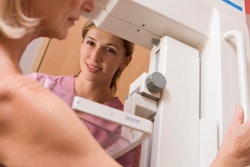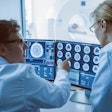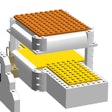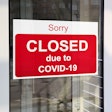
The proportion of women in England between the ages of 50 and 70 taking up routine breast screening invitations has fallen to the lowest level in 10 years, according to a new report. The emphasis on informing women about the pros and the cons of screening is thought to be behind the reduced attendance, but one expert is convinced the media is to blame.
Uptake -- defined as the percentage of women invited for screening in the year who were screened adequately within six months of invitation -- has dropped 2.5 percentage points over the past 10 years, according to the report Breast Screening Programme England, 2016-17, published on 31 January by NHS Digital.
| Screening uptake in England in women ages 50-70, 2006-2017 |
|||
| 2006-2007 | 2015-2016 | 2016-2017 | |
| No. of women invited to screening | 2.07 million | 2.48 million | 2.6 million |
| No. of women screened | 1.52 million | 1.79 million | 1.84 million |
| Uptake rate | 73.6% | 72.1% | 71.1% |
On a regional basis, uptake by women fell in all seven reporting regions in 2016-2017. The rate was highest in the East Midlands at 75.2%, and it was above the national minimum standard of 70% in all regions except the Northwest and London, where it was 68.8% and 64%, respectively (see map).
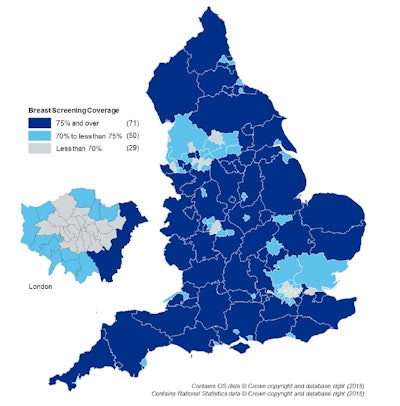
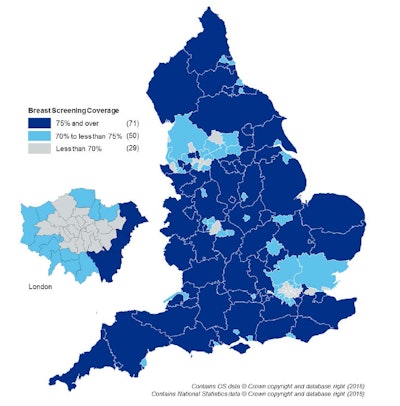
Breast screening coverage by county. Figure courtesy of NHS Digital.
Coverage, which is measured for women ages 53 to 70, remained relatively static for the third year in a row at 75.4% (4.48 million of 5.95 million) in 2016-2017, and remains above the National Health Service (NHS) Cancer Screening Programme's minimum standard of 70%. This compares with 75.5% (4.4 million of 5.83 million) in 2015-2016, and 73.8% (3.74 million of 5.07 million) in 2006-2007.
Under the NHS Breast Screening Programme, eligible women will usually receive their first routine invitation for breast cancer screening between the ages of 50 and 53, and they will normally be invited every three years until they are 70. Of all women with cancers detected through screening in 2016-2017, 41.5% (7,600 women) had invasive but small cancers, e.g., less than 15 mm in diameter and usually too small to detect by hand. This compares with 41.2% (7,500 women) in 2015-2016.
What's behind the lower uptake?
The reasons for the drop in attendance are difficult to define, but it may be due to the current trend to give women the facts -- the pros and the cons about screening -- to help them to make an informed choice about attendance, noted Dr. Andy Evans, a professor of breast imaging at the University of Dundee and honorary consultant radiologist at Ninewells Hospital and Medical School in Dundee.
 More emphasis now in screening is put on giving women all the facts, Dr. Andy Evans said.
More emphasis now in screening is put on giving women all the facts, Dr. Andy Evans said."In the past, there was a culture of encouraging attendance by highlighting the benefits and downplaying the harms," noted Evans, formerly director of the Nottingham International Breast Education Centre, in an email to AuntMinnieEurope.com. "The screening program continues to perform well, and it is up to the individual woman to decide if reducing her risk of dying of breast cancer is worth the potential harms of false-positive results and overdiagnosis, i.e., detecting cancers which would never threaten life."
But the mass media has contributed to women's anxiety over screening, according to Dr. László Tabár from Falun County Hospital in Sweden. He thinks the so-called fake news, scaremongering, and lies about the alleged overdiagnosis, harm, and overtreatment of breast cancer have had a major impact on women's attitudes and enthusiasm for screening.
In an email to AuntMinnieEurope.com, Tabár referred to "brainwashing" of women with negative news about what he believes is a "fabulous lifesaving method." Also, large pharmaceutical companies promote their own agenda, stating that better treatments, not screening, explain the reductions in breast cancer mortality rates, he wrote.
In defense of the mass media, the main problem is that some "tabloid journals" continue to publish low-quality, antiscreening papers that are then reported in newspapers, magazines, and websites, he added. Also, the peer-review system of journals is less comprehensive and thorough than it used to be, he noted.
NHS Digital is the national information and technology provider for the health and care system. It creates, delivers, and manages digital systems, services, products, and standards for the NHS in England. To download the full report from the organization's website, click here.






